Explore the mysterious realm of dark ambient music, where we create eerie soundscapes that transport you to supernatural dimensions.
With our imagination as our guide, we conjure haunting audio landscapes that defy convention and challenge the boundaries of sound.
Through the alchemy of brainstorming, field recordings, and digital manipulation, we layer sounds with precision and intention.
Join us on this sonic journey, as we delve into the depths of mood creation and incorporate chilling elements that will leave you mesmerized.
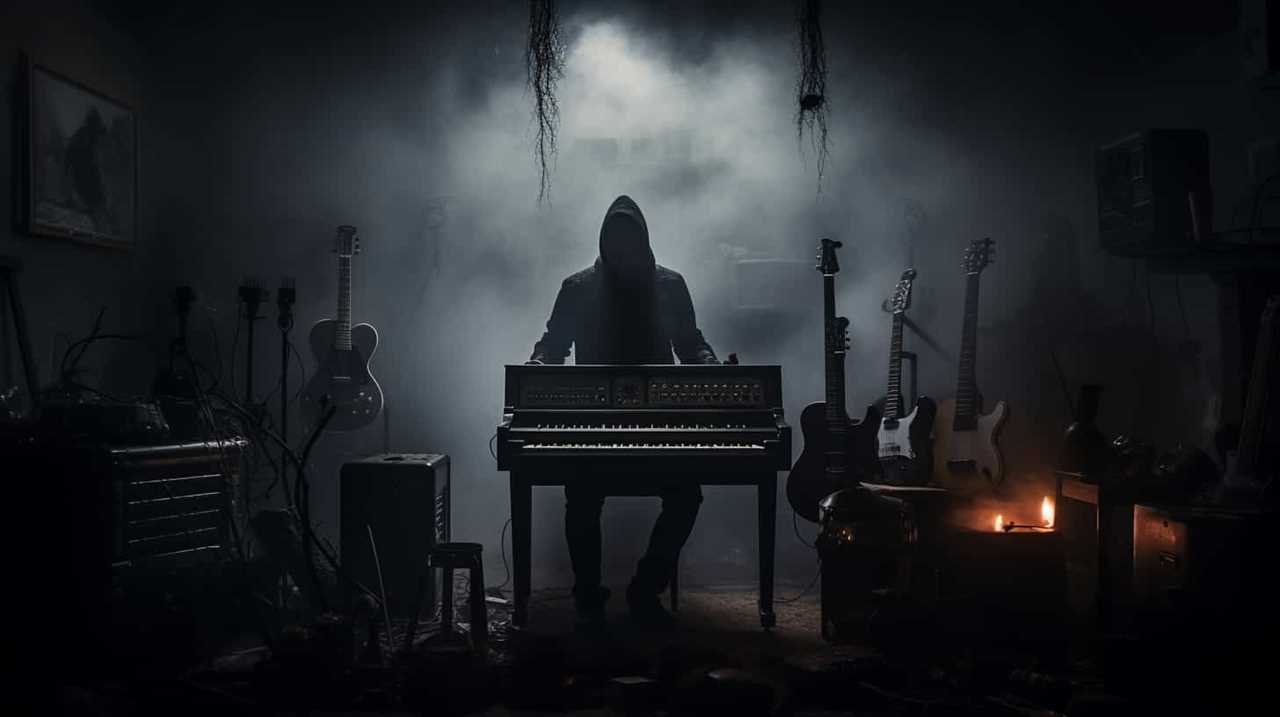
Key Takeaways
- Delve into exploring sonic textures and experiment with dissonance and harmony to create a rich tapestry of sound.
- Utilize field recordings to enhance atmospheric quality and add layers of realism and depth to the music.
- Manipulate sounds digitally using sound manipulation software to shape and transform them, opening up a world of sonic possibilities.
- Layer audio tracks to create a sense of depth and texture, incorporating a variety of atmospheric sounds and experimenting with unconventional instrumentation.
Brainstorming Sound Ideas
What are some ways we can brainstorm sound ideas to create haunting audio landscapes for our dark ambient music?
One approach is to delve into the realm of exploring sonic textures. By experimenting with dissonance and harmony, we can create a rich tapestry of sound that evokes a sense of unease and mystery.
We can manipulate the timbre of instruments, incorporate field recordings, and utilize unconventional sound sources to push the boundaries of our compositions.
The possibilities are endless, and the key is to let our imaginations run wild in this sonic exploration.
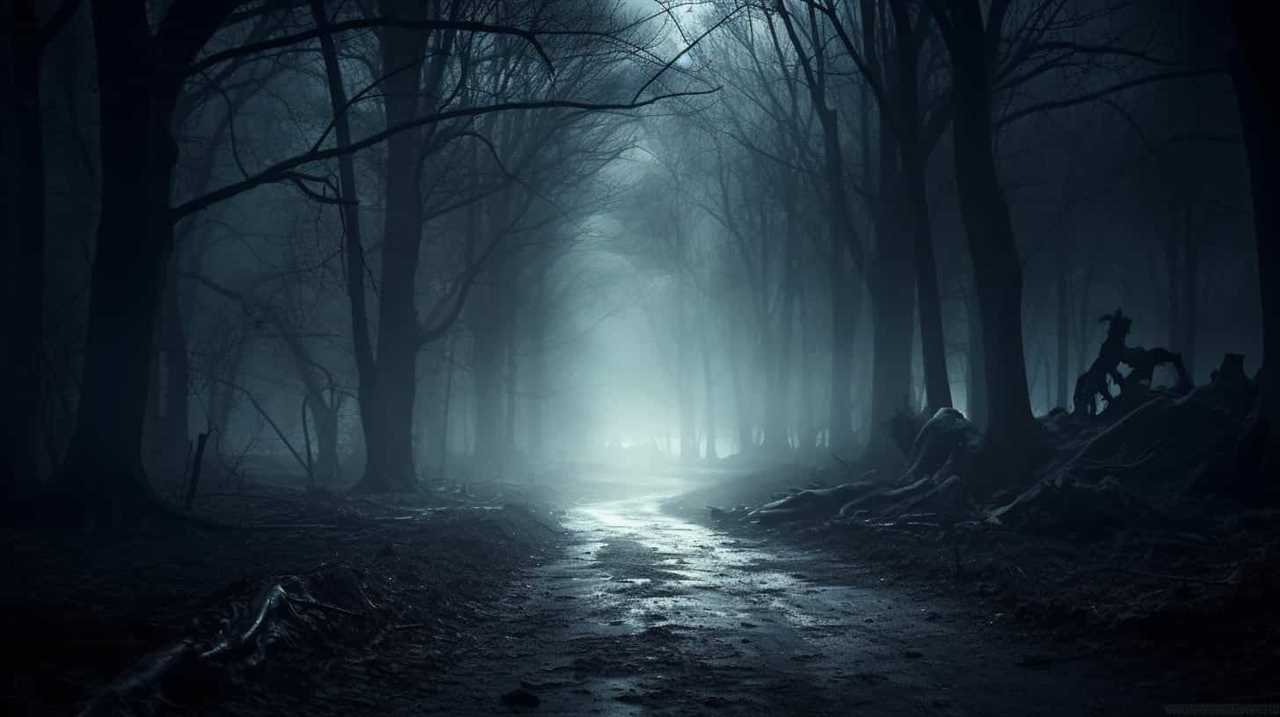
Utilizing Field Recordings
We can enhance the atmospheric quality of our dark ambient music by incorporating field recordings and manipulating them to create haunting audio landscapes.
Utilizing field recordings allows us to capture environments and bring them into our compositions, adding layers of realism and depth.
By blending these soundscapes and textures with our music, we can create immersive sonic experiences that transport listeners to new worlds.
Additionally, field recordings can serve as a foundation for sound effects creation and sound manipulation, providing endless possibilities for experimentation and innovation.
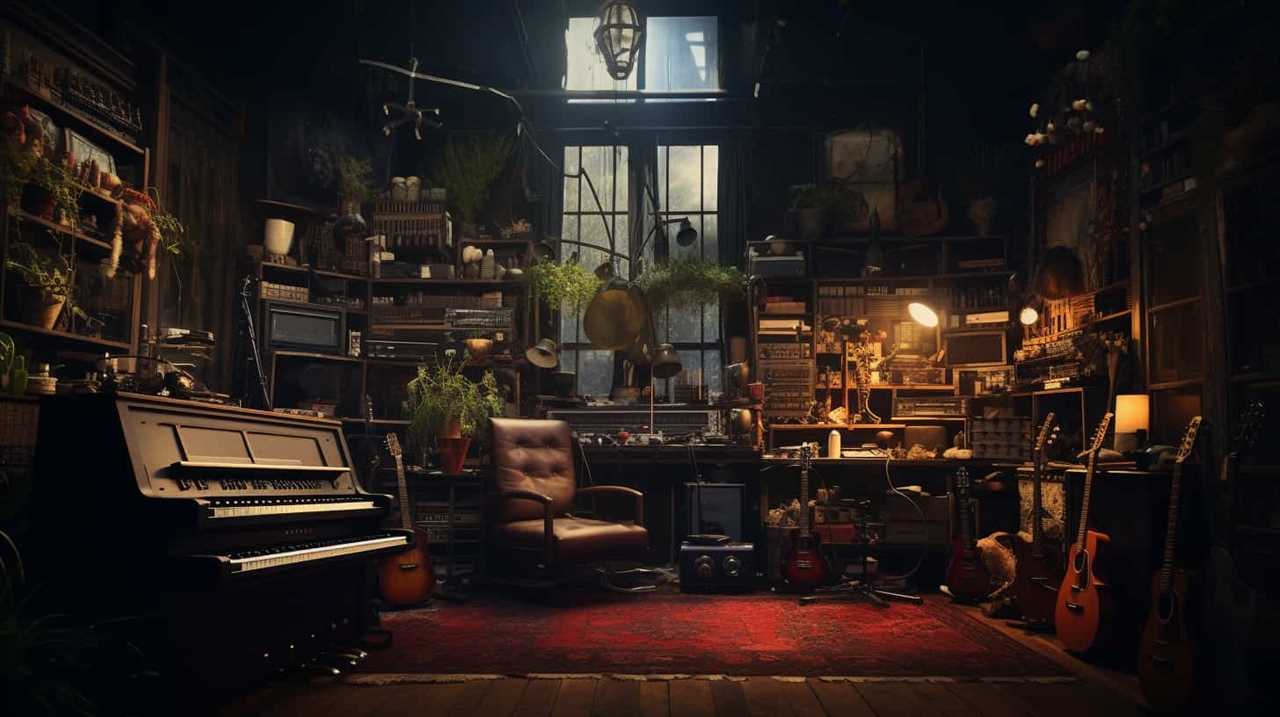
Manipulating Sounds Digitally
As we delve into the realm of manipulating sounds digitally, we can explore the vast array of tools and techniques available to craft eerie and immersive audio experiences.
Sound manipulation software, with its innovative features and capabilities, allows us to shape and transform sounds in ways previously unimaginable. From time-stretching and pitch-shifting to granular synthesis and spectral editing, these sound editing techniques open up a world of sonic possibilities.
Now, let’s delve into the art of layering audio tracks to further enhance our dark ambient compositions.
Layering Audio Tracks
Our goal in layering audio tracks is to create a sense of depth and texture by combining multiple sound elements into a cohesive and haunting sonic tapestry. To evoke emotion in our audience, we employ the following techniques:
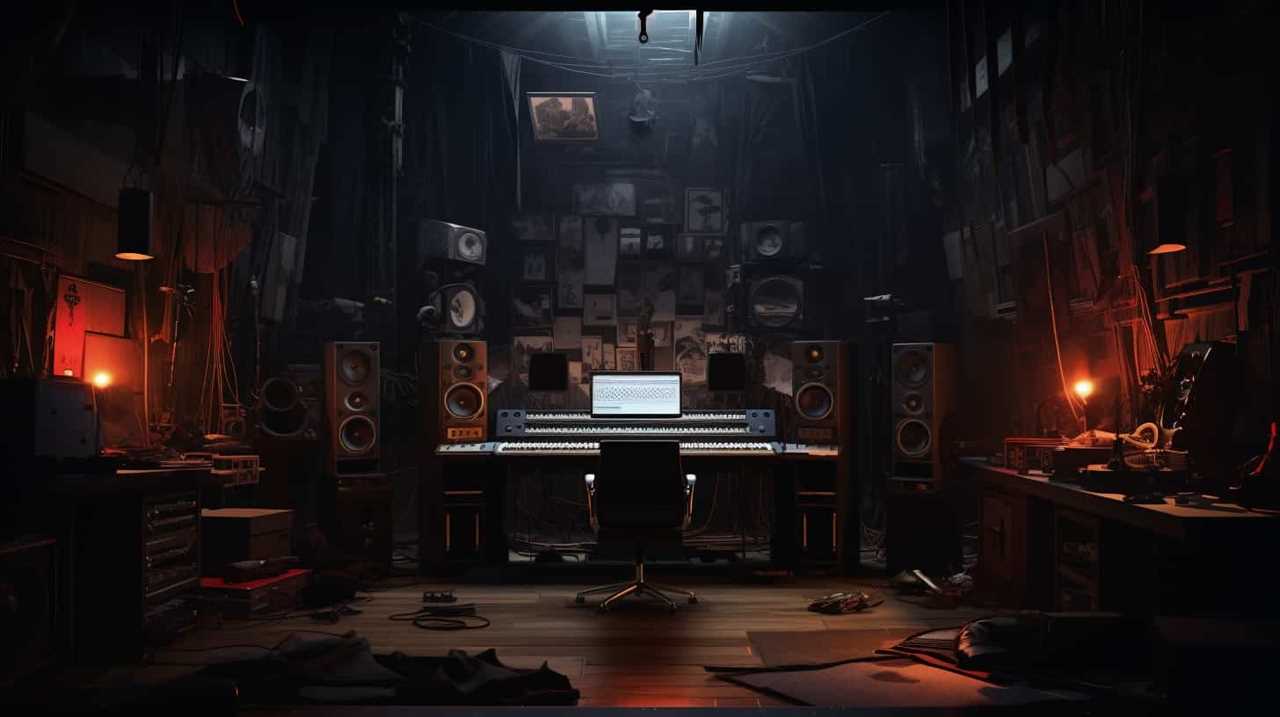
-
Exploring soundscapes: By incorporating a variety of atmospheric sounds, we transport listeners to eerie and otherworldly environments.
-
Creating tension: We use dissonant chords, unsettling melodies, and subtle rhythmic patterns to build suspense and unease.
-
Experimenting with unconventional instrumentation: By introducing unconventional instruments and manipulating their sounds, we push the boundaries of traditional music and create unique sonic experiences.
Focusing on Mood Creation
As we delve into the realm of mood creation, we find ourselves immersed in the art of evoking eerie atmospheres and manipulating emotional responses.

Through the careful selection of soundscapes, we can transport listeners to otherworldly dimensions, where the line between reality and imagination blurs.
Evoking Eerie Atmospheres
We use various techniques to craft chilling atmospheres that immerse listeners in a haunting sonic experience. To evoke emotion in our audience, we employ the following techniques:
-
Unleashing the otherworldly sounds of unconventional instruments, like the ethereal vibrations of a theremin or the mournful wails of a bowed saw.
-
Experimenting with spatial effects to create a sense of unease, such as using panning techniques to make sounds move around the listener or adding reverberation to create a haunting, cavernous effect.
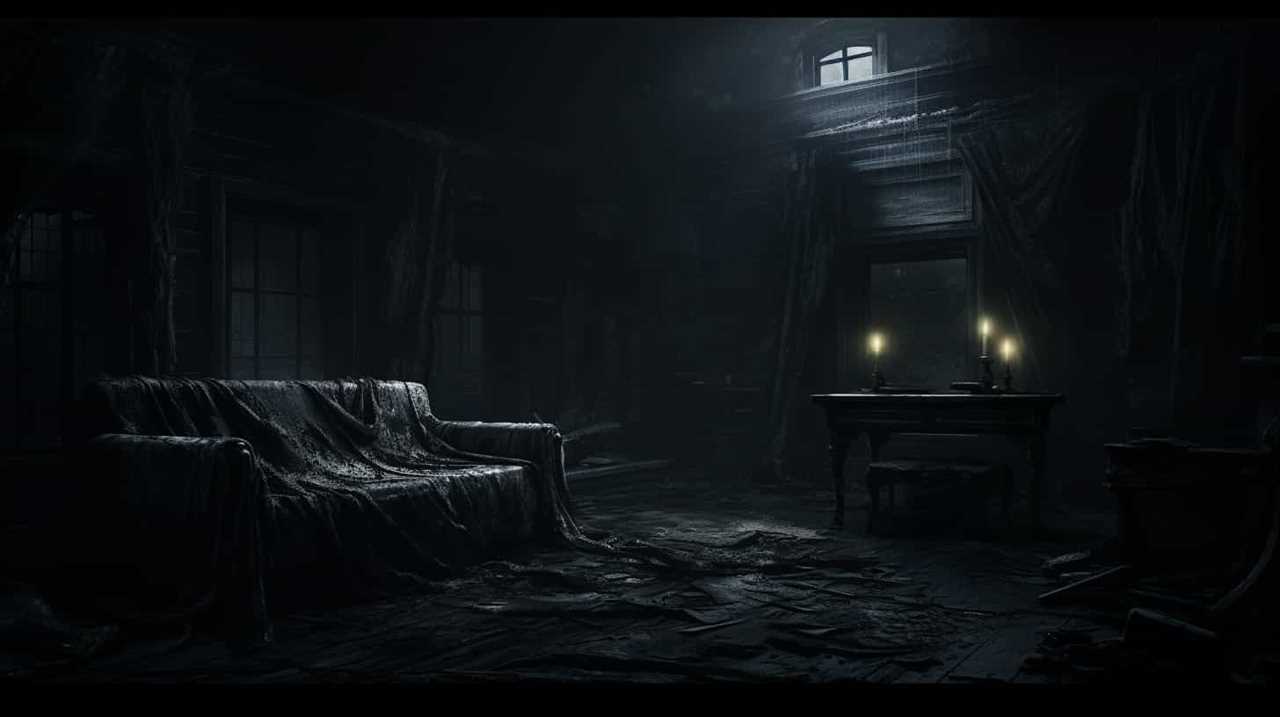
-
Layering dissonant melodies and unsettling harmonies to create an eerie and unsettling mood that lingers long after the music stops.
Manipulating Emotional Responses
To effectively manipulate emotional responses and create a specific mood, we can utilize various techniques in dark ambient music. By carefully crafting the sonic elements, we can evoke a psychological impact on the listener, drawing them into a world of haunting and introspection.
Sound symbolism plays a crucial role in this process, as certain sounds can symbolize emotions or concepts, allowing us to communicate on a deeper level and elicit profound emotional reactions.
Through experimentation and innovation, we can craft immersive soundscapes that resonate with the listener’s soul.

Incorporating Horror Elements
As we continue our exploration into the creation of dark ambient music, we now turn our attention to the spine-chilling realm of incorporating horror elements.
In order to evoke an eerie atmosphere, we delve into eerie sound design techniques, manipulating frequencies and textures to send shivers down the listener’s spine.
Building suspenseful atmospheres becomes our mission, as we experiment with dissonant chords, eerie drones, and unsettling rhythms.
And to truly immerse our audience in a world of terror, we embrace the power of chilling instrumentation, utilizing haunting melodies and ghostly voices to elicit a sense of unease.

Eerie Sound Design Techniques
Our goal is to incorporate a few chilling sound design techniques into our dark ambient music, creating an eerie atmosphere that will send shivers down the listener’s spine. To achieve this, we employ a range of innovative methods that tap into the psychological effects of fear and create immersive experiences.
Here are three techniques we use to evoke a sense of unease and suspense:
-
Layering dissonant tones and unsettling frequencies to create an unsettling sonic landscape.
-
Experimenting with unconventional instruments and found sounds to add a sense of mystery and otherworldliness.

-
Utilizing strategic silence and sudden bursts of sound to startle and unnerve the listener.
Building Suspenseful Atmospheres
We combine eerie melodies with haunting sound effects to build suspenseful atmospheres in our dark ambient music. Creating tension is a crucial element in our compositions.
We experiment with unconventional instruments and techniques, pushing the boundaries of sound to evoke a sense of unease and anticipation.
Utilizing silence is equally important, as it allows the listener to anticipate what comes next, heightening the suspense.

Our goal is to craft immersive, innovative soundscapes that captivate and disturb the senses.
Utilizing Chilling Instrumentation
During the composition process, we often experiment with chilling instrumentation and incorporate horror elements to create an unsettling and haunting atmosphere in our dark ambient music.
To achieve this, we explore synthesizers to generate eerie and otherworldly sounds that send shivers down the spine.
We also experiment with effects like distortion, reverb, and delay to add depth and texture to the music, creating an immersive and macabre sonic experience.

Frequently Asked Questions
What Are Some Effective Techniques for Creating a Sense of Unease or Suspense in Dark Ambient Music?
When it comes to creating a sense of unease or suspense in dark ambient music, we’ve found that there are a few effective techniques.
One way is by playing with tempo and rhythm, creating tension through subtle changes and unexpected pauses.
We also like to experiment with dissonant harmonies and textures, layering eerie sounds to create an unsettling atmosphere.
These techniques help us craft haunting audio landscapes that push the boundaries of traditional music and immerse our listeners in a truly atmospheric experience.

How Can I Incorporate Unconventional or Experimental Sounds Into My Dark Ambient Compositions?
When it comes to creating atmospheric textures in our dark ambient compositions, we love to incorporate unconventional and experimental sounds. By blending found sounds with eerie synths and haunting melodies, we can craft truly unique and unsettling audio landscapes.
We explore the depths of sound manipulation, pushing boundaries and experimenting with unconventional recording techniques. This allows us to create a sense of unease and suspense that’s truly innovative and captivating for our audience.
Are There Any Specific Field Recording Locations or Environments That Work Particularly Well for Capturing Eerie or Haunting Sounds?
When capturing eerie or haunting sounds, specific field recording locations and environments can greatly enhance the atmosphere of our dark ambient compositions.
By immersing ourselves in abandoned buildings, dense forests, or desolate landscapes, we can uncover unique and unsettling sonic textures.

Additionally, incorporating found objects into our music adds an extra layer of experimentation and creativity.
What Are Some Recommended Software or Plugins for Manipulating and Distorting Audio to Achieve a Haunting Effect in Dark Ambient Music?
When it comes to manipulating audio in dark ambient music, there are some recommended software and plugins that can help achieve a haunting effect. We explore how to use effects processors to create chilling audio effects and recommend hardware and equipment that can enhance the overall experience.
Experimenting with these tools allows us to push the boundaries of sound and create unique, atmospheric landscapes that captivate our audience’s imagination.
Let your creativity flow and dive into the world of dark ambient music.

Can You Provide Any Tips for Effectively Layering Multiple Audio Tracks to Create a Dense and Atmospheric Sound in Dark Ambient Music?
When layering multiple audio tracks to create a dense and atmospheric sound in dark ambient music, we find that the key is to experiment with different layering techniques.
By combining various elements, such as drones, field recordings, and manipulated sounds, we can create tension and release within our compositions.
We strive to push the boundaries of traditional music-making, exploring unconventional methods to achieve unique and haunting audio landscapes.
Through this experimental approach, we aim to captivate our audience with innovative and immersive sonic experiences.

Conclusion
As we delve deeper into the world of dark ambient music, we discover that it’s a realm of endless possibilities and eerie beauty.
By combining field recordings, digital manipulation, and layering techniques, haunting audio landscapes are brought to life, captivating listeners with their atmospheric and experimental nature.
Imagine walking through an abandoned asylum, the faint echoes of distant footsteps and the haunting whispers of forgotten souls filling the air.
This is the power of dark ambient music, where the boundaries of sound are pushed to their limits, drawing us into a realm of spine-chilling enchantment.











